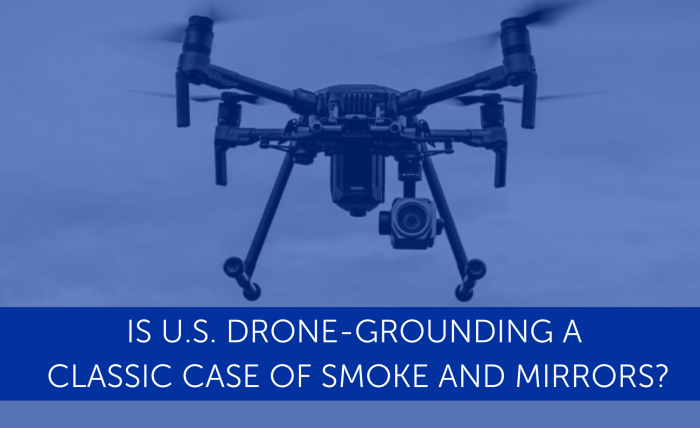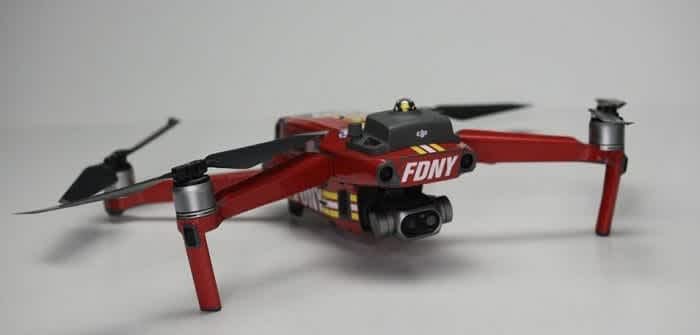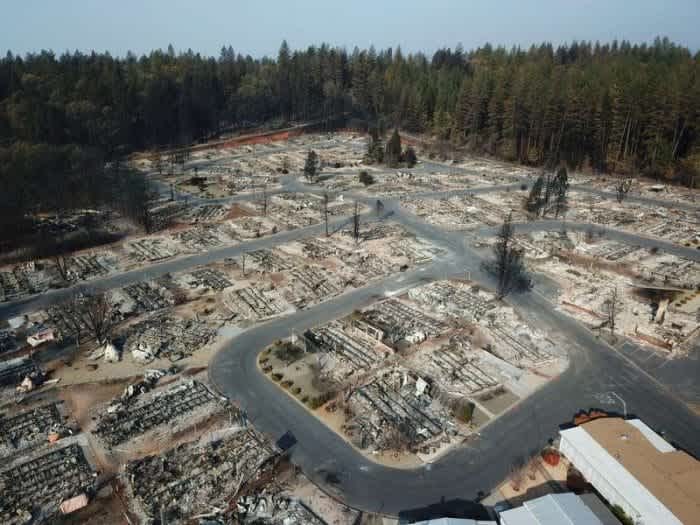
Updated on • 18 Aug 2024
Is US Drone-grounding A Classic Case of Smoke And Mirrors?
US Department of Interior grounds drone programme for 'security concerns', but DJI says this masks politically-motivated agenda to reduce market competition. ... Read More

US officials have grounded a civilian drone programme amid espionage concerns - but is this a classic case of smoke and mirrors?
At a time when relations between America and China are somewhat frosty, the US Department of Interior (DOI) this week issued an order to formally halt the department’s drones for non-emergency operations.
While it doesn’t directly specify Chinese-made aircraft, the sentiment is clear - considering that interior officials have acknowledged that all of the department's 800-or-so drones are made in or contain parts from the Far East.

A DJI M200 Series aircraft, used for industry and public safety.
Indeed, the DOI states that the purpose of the order is to 'better ensure cybersecurity' and claims that, in certain circumstances, 'information collected during UAS (Unmanned Aerial System) missions has the potential to be valuable to foreign entities, organisations, and governments'.
The formal grounding - an extension of an order made last year - reflects concerns among US officials about Chinese technology, espionage, and sensitive data. This is, after all, an issue which extends beyond drones, with phone manufacturer Huawei having also been dragged into the firing line. National security, US officials say, is key. Understandably, too.
But is there an ulterior motive? Is there more to this than meets the eye? Is this a case of protectionism over practicality?

A DJI Phantom 4 drone.
Shenzhen-based DJI - the world's leading drone manufacturer - clearly seems to think so, saying that the cyber-security accusations are masking a politically-motivated agenda to reduce market competition and support domestically-produced technology.
This stance from DJI certainly has substance.
Indeed, a statement from the DOI acknowledges that one of the reasons for making the order is to address 'domestic production concerns' and facilitate 'domestic production capability'.

The DJI Mavic 2 Zoom - an awesome photography drone.
Meanwhile, various media outlets suggest David Bernhardt, secretary of the US Department of the Interior, hopes US manufacturers will eventually replace foreign suppliers in an industry now dominated by China.
If this is the case, American firms face a long road to topple China's stronghold in the domestic drone market. The stark reality is that US home-grown UAS manufacturing is lagging way behind its Chinese counterparts, especially DJI.
Figures published by research company Drone Industry Insights (DII) towards the end of last year highlight the gulf between DJI and its competitors in the US market place.

The Drone Industry Insights table.
The Shenzhen company, synonymous with the iconic Phantom series, has amassed a whopping 76.8% of the market share.
To put this into perspective, USA company Intel - which makes the Falcon 8 - is second on the list, with just a 3.7% stake.
There is some cause for optimism in the US, as five of the top 10 companies hail from the States. But a huge amount of growth is needed to topple DJI from its perch, especially as it is a position which DJI holds for good reason.
Firstly, it is the longest-standing company in that Top 10 list, having been born in 2006.
Secondly, and most importantly, its technology is good. Really good. It's reliable, it's affordable, it's versatile, and it's flown in the US by consumers and commercial users across the enterprise spectrum - from public safety to wind-turbine inspections.

The Mavic 2 Enterprise Series boasts a range of features, including zoom camera and thermal sensor.
DJI has also repeatedly stressed that its drones are safe and secure - going so far as to say that independent security experts have tested and verified the aircraft.
And to rub salt into the wounds of those US critics, DJI and its products are bolstered by American technology. This includes partnering with Microsoft and integrating drones, like the M200 Series, with thermal cameras developed by Oregan-headquartered FLIR.
With this in mind, are the cyber-security concerns cloaking a burning desire to bolster the US production line, at the expense of overseas manufacturers? Are Chinese firms being punished for DJI's flourishing success State-side?
If this is the case, is the DOI cutting its nose off to spite its face?

The DJI M200 Series.
According to The Wall Street Journal, the department’s reliance on drones has ballooned in recent years. In 2018, Interior officials recorded 10,342 flights, mostly in Alaska, Hawaii, Oregon and California - double the number of flights in 2017.
The drones also save taxpayer money. In 2018, Interior officials estimated the department saved at least $14million by using drones instead of helicopters or airplanes.
Since the temporary ban was imposed last year, some Interior workers have complained that it has weakened their ability to survey erosion, monitor endangered species and inspect dams.
Despite the criticism, Mr Bernhardt said his department will be 'very able to meet its mission without sacrifice'. Time will tell.

The DJI Inspire 2 is a top-class cinematography drone.
But the problem is, by dropping DJI - whose aircraft makes up a portion of the DOI's fleet - the department will likely face mounting costs, because non-DJI-tech is expensive. Some will even say that it is less reliable and not as capable.
However, the DOI has drawn its line in the sand. It has tied its flag to the mast. This is its stance, for now.
So how will this impact DJI? Such is the company's dominance and longevity in the market, the DOI's grounding of its fleet is insignificant compared to the hundreds of thousands of DJI drones which are being used for private and commercial purposes in the United States.
After all, the DII figures show that the most popular types of DJI drone are Mavics and Phantoms - two Series synonymous with consumer use.

The DJI Mavic 2 Zoom.
However, DJI will surely hope that the DOI's stance does not erupt into a broader drone-industry-wide kick-back against Chinese tech.
The company will also be aware that this hysteria has the potential to tarnish its reputation - hence the constant attempts to clear its name and stress that sensitive data is not DJI's business.
But, barring a complete ban, it will be difficult to knock DJI off its perch. Until rival manufacturers can create products which can match the Phantom, Mavic and Matrice Series' for price and quality, DJI will remain Top Dog.

The DJI M200 Series can be integrated with thermal and zoom cameras.
For this reason, DJI is entrenched in the American drone market. DJI's ability to pump out incredible tech at competitive prices means they are the go-to manufacturer for many.
For instance, two of America's largest fire departments - New York and Los Angeles - utilise DJI aircraft. In fact, representatives from both departments were guest speakers at DJI's flagship AirWorks event last September, with LA's Battalion Chief Richard Fields describing drones (DJI tech) as a 'force multiplier in our daily operations.'

A New York Fire Department branded DJI Mavic aircraft.
In April 2019, the Los Angeles Fire Department even signed up to a Solution Development Partnership with DJI to create, test, and deploy drone technology as an emergency response and preparedness tool.
And this is another thing about DJI. The company goes beyond manufacturing drones. Rather, it places itself at the heart of the UAS community, working with those on the ground to forge links, solutions and best practises to streamline decision-making, transform response times and ultimately save lives.
The Disaster Relief Program (DRP) is evidence of this. Announced at AirWorks last year, the DRP is designed to support first responders in the United States by providing access to DJI’s industry-leading drone technology for response and recovery efforts during and after major disasters such as wildfires, hurricanes, floods, tornadoes, earthquakes and local emergencies.

DJI drones have helped to map the aftermath of wildfires in California.
Let's not forget, DJI officials were on the frontline during the devastating Californian wildfires, using the company's drones to make a difference to the recovery efforts. In the aftermath, work has been ongoing to develop efficient drone deployment strategies for future wildfires - with DJI staff at the centre of these talks.

This type of work and partnership-building is vital for harnessing the true capabilities of drones and their associated benefits. And, in the context of the dark clouds which hang over Chinese technology manufacturers, it makes DJI something of an anti-hero.
For the time-being though, this won't stop some US officials from standing-by their data-security claims and pointing a sceptical finger at firms like DJI.
But rest assured, DJI will fight to protect its name and reputation in every way it can - all while continuing to innovate and build the drone industry.

written by
James Willoughby
James joined heliguy™ in 2018 following a 13-year stint in print and online journalism, having worked on regional and weekly newspaper titles. He is responsible for spearheading heliguy™'s content strategy and social media delivery. James collaborates with DJI Enterprise's European marketing team to coordinate and produce case studies and helps organise events and webinars.